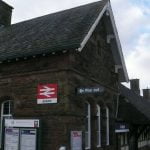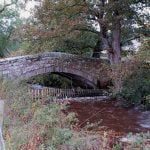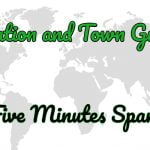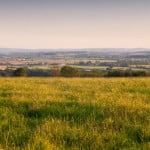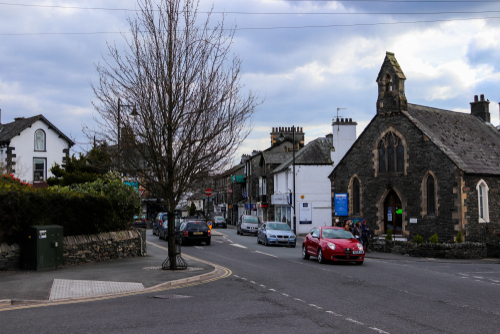
Windermere is a popular Lake District town with a lake named after it (or more probably vice versa). Whatever like its near neighbour Bowness it makes a great base to explore the area and there is a surprisingly varied amount of things to do locally and attractions to see.
Go to the Cumbria Business Directory
Where Is Windermere
Windermere is a town and civil parish in the Lake District of Cumbria, northwest England. Lake Windermere actually lies about a mile (1.6 km) west of the eponymously named town. It would be easy to confuse the town of Windermere with the nearby older but smaller lakeside settlement of Bowness-on-Windermere. While the civil parish encompasses both settlements, the two towns retain distinctly separate town centres and identities. In the 2011 UK Census, the population of Windermere and the surrounding area was assessed as being 5,837, while that of the wider civil parish, which includes Bowness-on-Windermere, was 8,359.
A Fleeting History
The word ‘Windermere’ is thought to have been derived from either ‘‘Winand’s’’ or ‘‘Vinand’s’’ lake, being old Swedish and Germanic names, which tells of the Lakes past settlement by both the Saxons and Vikings. The term ‘mere’ is an Old English word, meaning ‘lake’ or ‘pool’. There are written references to “Wynandermer” dating from as early as 1396.
The early settlement of the Windermere area occurred around Bowness. A rectory was built there around 1415, on the site of the present St Martin’s parish church, which itself dates from 1483. It’s known that was around the same time that public ferry crossings of the lake began. By the 17th century, an informal Sunday had market grew up around the church. In 1692, the locally famed theologian and antiquarian, Thomas Machell, described Bowness as “a small country village, with a schoolhouse and with nine or ten other houses about it, where there is a sort of market or meeting place lately begun”.
1847 The Railway Arrives
In contrast, Windermere is a much newer settlement, that grew up around the railway station that was built there 1847. Prior to the arrival of the railway, Windermere or ‘Birthwaite’ as it was then known, was nothing more than a tiny hamlet in the township of Applethwaite. In 1841, the whole of Applethwaite had only 436 inhabitants. However, aided with the post railway arrival growth of Windermere, Applethwaite’s population rose dramatically to 1,285 by 1861 and 1,926 by 1891.
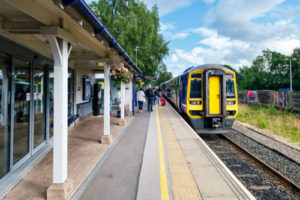
Windermere railway station. Photo: Kamira/shutterstock.com
The fortunes of Birthwaite changed dramatically once it was connected to the national railway network, since the largely unexplored Lake District, was for the first time made accessible to the masses. And, in particular, to the inner-city working class throughout the North of England. Renowned romantic poet, William Wordsworth was notably opposed to the railway, along with many of the residents of Bowness. Nonetheless, bolstered by government policy, the development still went ahead.
What’s In a Name
However, it was the local topography that stopped the railway station being built at the lakeside in Bowness. The local 1.5-mile gradient down to the lake was too steep for a train to manage, so the station had to be built at the top of the grade at Birthwaite. However, the railway company stipulated that the station should be named ‘Windermere’ so as to emphasize the place’s connection with the lake. The local authority soon followed suit, deciding it would be advantageous for the area if they changed the village name to Windermere.
The main sources of employment in and around the Applethwaite, prior to 1847, were cattle and sheep farming, quarrying, forestry and fishing. Once, the railway had arrived, the quickly growing village of Windermere began to experience change. As well as a newfound tourist industry, there was also industrial growth with bobbin mills being opened at Troutbeck Bridge and Thickholme. In 1893, a hydroelectric power generation plant came into operation at the Troutbeck Bridge bobbin mill. Windermere, along with Bowness, was one of few boroughs in England to have electric street lighting at that time. The slate quarrying operations at Applethwaite Common also expanded in the late 19th century.
Between 1894 and 1974, Windermere was administered as an Urban District Council (UDC). In 1905, the Windermere and Bowness-on-Windermere UDC’s were merged, although they did retain separate civil parishes until 1974. In 1934, Windermere’s Urban District underwent some minor boundary changes which were retained until the authority was abolished under the 1972 Local Government Act.
Alfred Wainwright
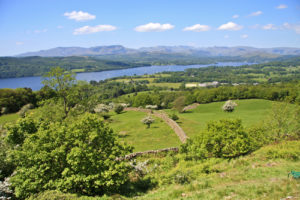
A view of Lake Windermere from Orrest Head Photo: PhilMacDPhoto
In 1930, a 23-year-old, Alfred Wainwright, travelling from Blackburn, arrived in Windermere on his first-ever trip to the Lake District. He went on to climb the nearby 784- feet high Orrest Head during his stay and became immediately enchanted with the Lakes. Moving to Kendal in 1941, he famously went on to write an extensive series of books and guides on the Lake District, which were published in the 1950s and 60s. Wainwright’s books are still very popular today and are responsible for promoting both Winderemere and wider Lake District
In 1941, during WW2, an aircraft factory building Sunderland flying boat was set up on the shores of Windermere at White Cross Bay. The site was chosen because the aircraft needed a large expanse of water from which to take off and because of its relative isolation. At production peak in 1942, the factory had a workforce of 1,571. At the end of the war, the factory buildings were used as storage units. The Troutbeck hydro-electric power generation plant ceased operation in 1948. The site of the White Cross aircraft factory closed in 1951.
Modern Windermere
In 1974, the changes proposed under the Local Government Act were enacted, which saw the merger of the Bowness and Windermere civil parishes. The newly founded much larger parish retained the Windermere name, along with the creation of a town council of the same designation. However, the primary duties and responsibilities of local government were transferred to the administration of the newly founded South Lakeland District Council.
Today, the local economy of the general Windermere area is reliant on tourism. However, while Bowness is very orientated towards the tourist market, Windermere much less so, and viewed more of a service cum market town. However, it does enjoy the upside of tourism, meaning that there are plenty of quality independent shops, pubs, cafes and restaurants in the town.
Getting To Windermere
By Road
The M6 motorway runs north to south just to the east of the Lake District, so here are several ways to get to here from the M6. If you’re travelling by car from either the north or the south, the slightly shorter route is turn off at Junction 37 (Killington Lake), proceed along the A684 to Kendal, and then take the A590 to Windermere. For a more scenic route from the north, turn off at Junction 39 (Shap) and proceed along with the A6 to Kendal, then take the A590. You can take a more picturesque journey from the South by turning off at Junction 36 onto the A590. Then follow the A591, bypassing Kendal. A word of warning, car parking can be difficult to find, especially during the summer months.
By Train
For train travellers, there is the Lakes Line that runs between Windermere and Oxenholme, with local trains stopping at the towns of Staveley and Kendal. The West Coast mainline runs to the east of the Lake District, connecting Oxenholme to Carlisle, Glasgow and Edinburgh to the North, and Preston, Manchester and London to the South. There is also a direct train which runs from Manchester. Note that you can take a bike on any rail services to the Lake District, but conditions apply.
By Bus
Windermere is well connected to other Lakeland towns and villages by local bus services. These services are operated by national carrier Stagecoach, who provided additional buses during the summer months. If you arrive by train the good news is that buses stop at the station forecourt for Bowness, Ambleside, Grasmere and beyond. Similarly, if you arrive at Bowness Pier, the local council provide frequent buses around town.
By Air
The nearest main airports are Manchester to the south and Glasgow to the north. Carlisle (Lake District) Airport offers flights to and from Dublin, Belfast and London (Southend).
Things to see and do!
There are plenty of places to see in and around Windermere, which include:
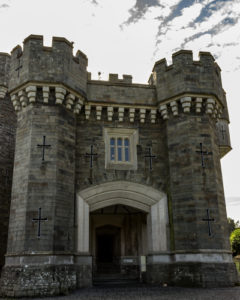
The gothic revival ‘Wray Castle’ Photo: Mr Z Photography
Hill Top
Hill Top was the home of Beatrix Potter. When she died in 1943, she left Hill Top to the National Trust with the proviso that it be kept exactly as she left it, complete with her furniture and china.
Orrest Head
A short walk from Windermere takes you to Orrest Head, an outstanding viewpoint. In 1930, it was the first ‘summit’ in Lakeland visited by Alfred Wainwright, author of the famous guidebooks.
Wray Castle
Wray Castle is a Victorian neo-gothic building at Claife, close to the west shoreline of the Lake about 10 miles from Bowness. The house and grounds have belonged to the National Trust since 1929, but the house has only recently opened to the public. The grounds are open all year round and are renowned for the large selection of exotic trees.
Lake Windermere Cruises
There is a wide range of cruise trips available at the Lake, varying from 45 minutes up to 48 hours. Most cruises make stops at Wray Castle and other local places of interest. Obviously, there are great panoramic scenery and plenty ‘famous five’ style islands to view in the lake. The springtime walker’s ticket combines 2 boat cruises with a 4-mile walk along the relatively quiet western shore of the lake.
The World of Beatrix Potter
The World of Beatrix Potter is a family attraction that brings to life all 23 of her stories, recreating the local countryside. The exhibition also features some of Potter’s most beloved characters, including Peter Rabbit and Mrs. Tiggy-winkle.
Watersports
If you fancy a go at watersports you’ll find it easy to hire a canoe or kayak at the lake. These vessels are simple to get the hang of and don’t require previous experience. For the more audacious, you could try stand-up paddleboarding. Most people find it a little more difficult than canoeing or kayaking, but well worth the effort if you can master it. You’ll also be able to find qualified instructors around the lake, ready to pass on their specialist watersport knowledge.
Treetop Trekking
At Windermere’s Treetop Trek you get the opportunity to climb 40ft into the canopy of ancient oak woodland. The trek is open to both adults and children, as there are walkways, tunnels, slides and giant trampolines. There are great views of the Lake, and to finish up, there’s a 250m zip wire descent.
Where to stay?
There is a good range of places to stay in and around Windermere from luxury self-catering cottages to quality hotels and bed and breakfasts. A rough estimate of accommodation costs in and around Windermere would be:
Guesthouse/B & B: £60 – £ 80
Hotel: £80 – £130
Holiday home: £70 – £90 pp per night for max occupancy
Why Not Take the Bowness – Windermere Quiz?
Photo Credit: Darrell Evans/shutterstock.com
